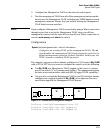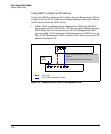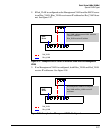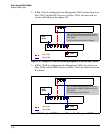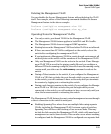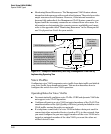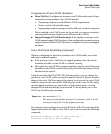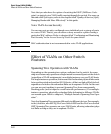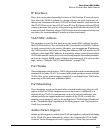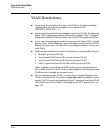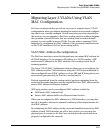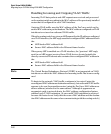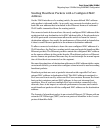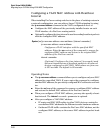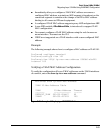
Static Virtual LANs (VLANs)
Effect of VLANs on Other Switch Features
IP Interfaces
There is a one-to-one relationship between a VLAN and an IP network inter-
face. Since the VLAN is defined by a group of ports, the state (up/down) of
those ports determines the state of the IP network interface associated with
that VLAN. When a port-based VLAN or an IPv4 or IPv6 protocol-based VLAN
comes up because one or more of its ports is up, the IP interface for that VLAN
is also activated. Likewise, when a VLAN is deactivated because all of its ports
are down, the corresponding IP interface is also deactivated.
VLAN MAC Address
The switches covered by this guide have one unique MAC address for all of
their VLAN interfaces. You can send an 802.2 test packet to this MAC address
to verify connectivity to the switch. Likewise, you can assign an IP address to
the VLAN interface, and when you Ping that address, ARP will resolve the IP
address to this single MAC address. In a topology where a switch has multiple
VLANs and must be connected to a device having a single forwarding database,
such as the Switch 4000M, some cabling restrictions apply. For more on this
topic, refer to “Multiple VLAN Considerations” on page 2-20.
Port Trunks
When assigning a port trunk to a VLAN, all ports in the trunk are automatically
assigned to the same VLAN. You cannot split trunk members across multiple
VLANs. Also, a port trunk is tagged, untagged, or excluded from a VLAN in the
same way as for individual, untrunked ports.
Port Monitoring
If you designate a port on the switch for network monitoring, this port will
appear in the Port VLAN Assignment screen and can be configured as a
member of any VLAN. For information on how broadcast, multicast, and
unicast packets are tagged inside and outside of the VLAN to which the
monitor port is assigned, refer to the section titled “VLAN-Related Problems”
in the “Troubleshooting” appendix of the Management and Configuration
Guide for your switch.
Jumbo Packet Support
Jumbo packet support is enabled per-VLAN and applies to all ports belonging
to the VLAN. For more information, refer to the chapter titled “Port Traffic
Controls” in the Management and Configuration Guide for your switch.
2-63



